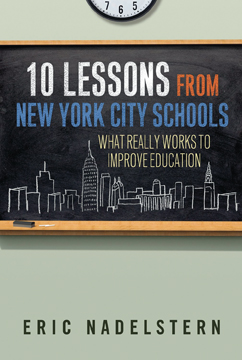 10 Lessons from New York City Schools: What Really Works to Improve Education
10 Lessons from New York City Schools: What Really Works to Improve Education
Eric Nadelstern
Teachers College Press, 2013
84 Pages
By Gail Bush
For those in the service of youth, hope springs eternal at summer’s end. Back-to-school season triggers memorable sensory registers: the smell of sharpened pencils, the smooth cover of the composition book with its sea of untouched pages, the sounds of gathering youth returning to their primary occupation of student. For educators, the senses seem heightened, eagerly seeking fresh approaches to make the upcoming year the most engaging, effective, and productive year of their professional lives.
“10 Lessons from New York City Schools: What Really Works to Improve Education” by Eric Nadelstern has obvious appeal to administrators in the employ of large urban school districts, but the deeper message is directed at all educators and policymakers who have a passion for student success. The author focuses on a 10-year tenure during which Michael Bloomberg was New York City’s mayor, Joel Klein was the chancellor of schools, and Eric Nadelstern was the deputy chancellor. The decade from 2002 to 2011 was known as the “Children First” initiative in New York City public schools.
Judging a book by its cover (or title and subtitle) suggests that Nadelstern has written a “how-I-done-good” guide to school-system management. Impressively, this assumption is only partially correct. Nadelstern, whose career also includes being a public school teacher, principal and superintendent, has written an honest report from his perspective of those soft spots in a hardened, traditional institution where change is possible. With change comes starts and fits, mishaps and pitfalls, and the reader learns of those as well.
Nadelstern writes both with the clarity of hindsight and appreciation of obstacles gained in his new position as a professor of practice at Columbia University Teachers College. He openly shares his own successes and abysses, misunderstandings and incremental improvements, bold confrontations and subtle conversations. Through this seemingly transparent documentation of the Children First decade, “10 Lessons” has appeal to all educators and others in service to youth.
Nadelstern shares two key directives to readers: 1) personalize education and 2) be accountable. First and foremost, student performance, as an observable demonstration of learning, must remain central to all efforts. Learning must be individualized, and in order for that to happen we must know our students. Students must feel that someone truly identifies with them and acknowledges who they are, their circumstances and their dreams. Nadelstern’s lessons of creating small schools, reducing teacher load and relentlessly focusing on student learning share this basic and powerful message.
Lessons of accountability include rewarding success and exacting consequences from those serving students— and also reforming administrative practices of the central office. Nadelstern contends that good teachers already hold themselves accountable with high standards for their students’ learning as a measure of their productivity and desired outcomes. Nadelstern says the paradigm shift toward accountability includes both rewards and consequences. Exacting consequences for failure to thrive through poor performance from educators is an equally important and a more challenging dynamic than rewarding successes. Nadelstern is particularly invested in eliminating the gap, both racial and socioeconomic, in the graduation rates, and in providing accessible postsecondary learning opportunities. A 50 percent graduation rate does not satisfy the author, and he is baffled that others do not share his outrage.
Nadelstern understands how administrative strongholds often confound good intentions. Following “Bloomberg’s Rules of Successful Management,” Nadelstern encourages leadership by “recruiting the best people you can find; supporting them; providing incentives for good work; protecting them from outside interference; and holding them accountable for the highest standard of performance.” Decentralizing authority, and sharing responsibilities and resources, must be carefully managed, but when operational, they fuel innovation. Empowering professionals at all levels to seek their most effective connections with youth has lasting results.
Additionally, Nadelstern writes about being resourceful with these lessons: support leadership by giving administrators the tools and resources needed to be effective; ensure that the authority that comes with leadership is shared to be most successful; and in the ultimate act of resourcefulness, be collaborative. According to Nadelstern, “If we’re to reestablish hope and promise for those who depend on our schools for their share of success in the workplace, the public sector will need to work together more effectively with the private and not-for-profit sectors.” Both sectors share the same mission of service to improve the community. While public organizations that serve youth might be hesitant to seek support from local businesses, Nadelstern emphasizes how the private sector needs community partners to help fulfill their mission to serve as good neighbors. In New York, for example, the school district partnered with numerous foundations and nonprofits, including the Gates and Carnegie Foundations and New Visions for Public Schools as well as local universities.
At the core of Nadelstern’s motivation for becoming a change agent in the nation’s largest public school district was the 50-year status quo statistic of a 50 percent graduation rate. Understanding this heartfelt catalyst provides a strong premise for this guide and gives shape to a productive career in public education. Nadelstern writes in his Afterword that the lessons he shares are not cumulative and can be used in any order. “10 Lessons” is a cogent primer with each lesson-chapter only a few pages. His brevity proves efficient since it allows each lesson to be illuminated without unnecessary discussion.
In a recent interview with Matchbook Learning, where he now serves as the Chief Academic Advisor, Nadelstern insisted that in order for all students to reach their full potential, “high school graduation with postsecondary learning opportunities needs to be the new baseline expectation for all children.” Toward that goal, he hopes this book becomes that “well-worn, dog-eared handbook” that educators keep at the ready. What better time than back-to-school season to seek a fresh approach for the school year ahead?


























